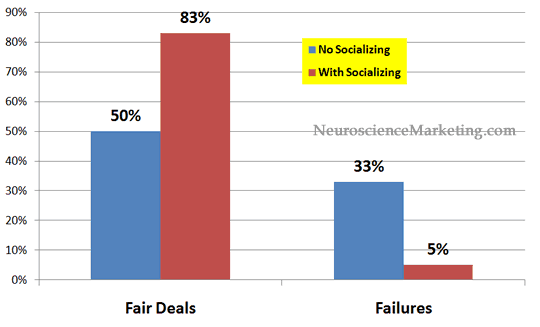It Really DOES Pay to Schmooze
One of my all-time favorite TV commercials is the classic 1990 United Airlines spot that shows a manager distributing plane tickets to the sales staff so they can visit their customers in person. This was filmed in the days before email and the Web, but even then phones and faxes were viewed as a substitute for face to face meetings. Here it is:
This ad works because it tells a story that resonates with its audience and also because of its acting and production values; it’s a full-blown business drama packed into a 60-second commercial. As it turns out, there’s research that backs up United’s implied claim that there’s no substitute for face-to-face customer contact. Good, old-fashioned face time can have a significant impact on trust and behavior.
Experiment Shows Power of Socializing
Scientists love to create artificial situations to mimic the real world, and one of the classics is a setup known as the Ultimatum Game. In it, one participant decides how to share a sum of money (e.g., $10) with another subject. The second subject can accept or reject the split. In the event the split is rejected, nobody receives any money. While classic economic theory suggests that any non-zero offer should be accepted (since even a dollar is better than nothing), real people tend to reject “unfair” offers that are too skewed toward the first subject.
In the standard Ultimatum game, about half of all splits are “fair” – within 10 points of a 50-50 split. A third of the splits are rejected, presumably because they are perceived as unfair.
As described in Secrets of the Moneylab by Kay-Yut Chen and Marina Krakovsky, researcher Al Roth tried an interesting twist on the Ultimatum game – he had the subjects talk face-to-face before playing. Amazingly, even when the subjects were told not to discuss the game and chatted about random topics, they were far more likely to successfuly split the money. With the conversation, the percent of “fair” offers rose to 83%, and a mere 5% of the games resulted in failure.

That’s a stunning difference, and shows that establishing rapport with another person really does alter behavior.
So, don’t be in too much of a rush to get down to business. Time spent chatting about kids, golf, or the upcoming weekend may SEEM like a waste of time, but it’s laying the groundwork for mutual respect and trust. The likelihood of reaching a deal that satisfies both parties will increase. An interesting probability is that connecting electronically via social media could have a similar effect; certainly, a full video connection like Skype or Webex would seem to allow some level of face-to-face socializing?

